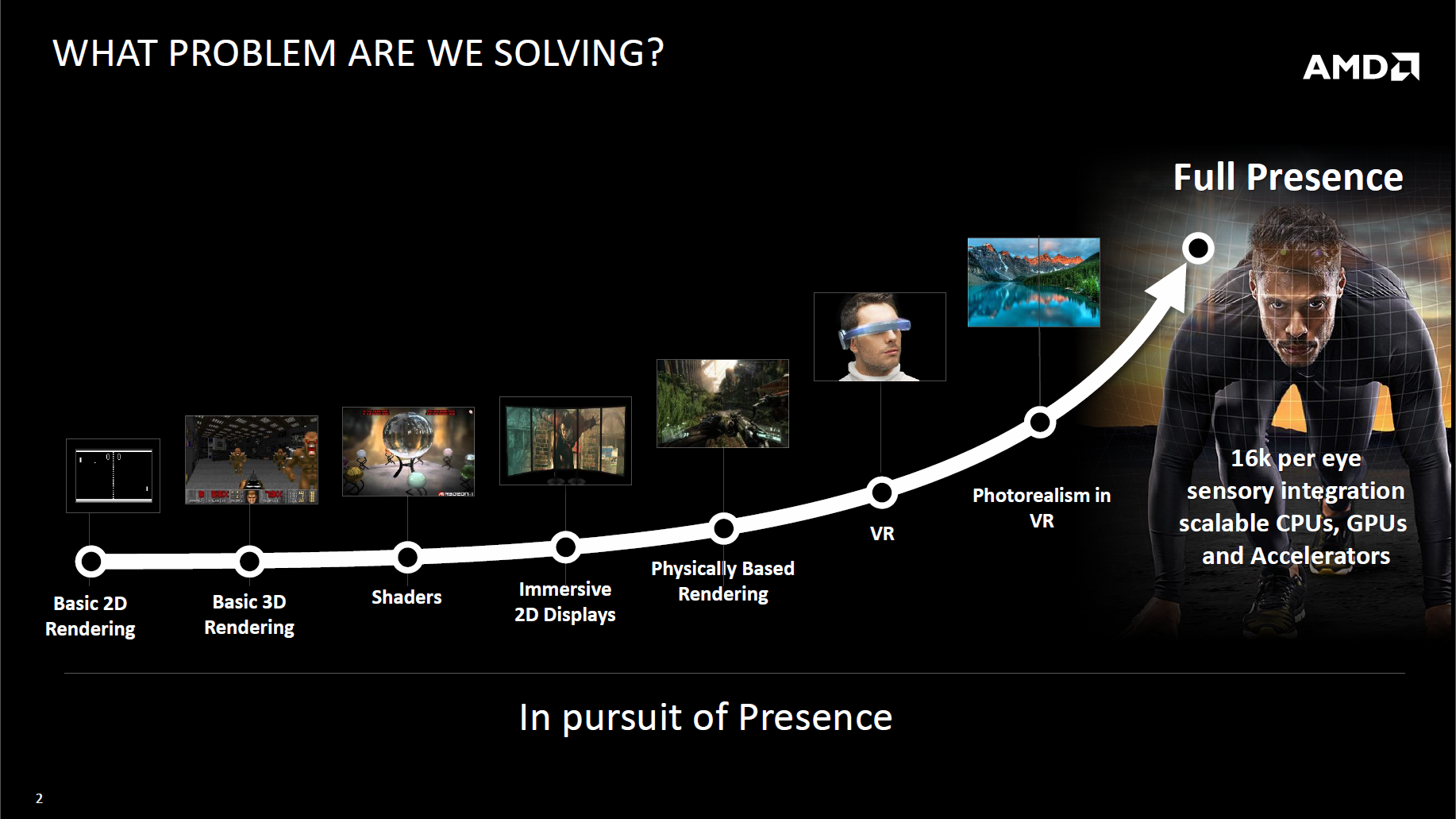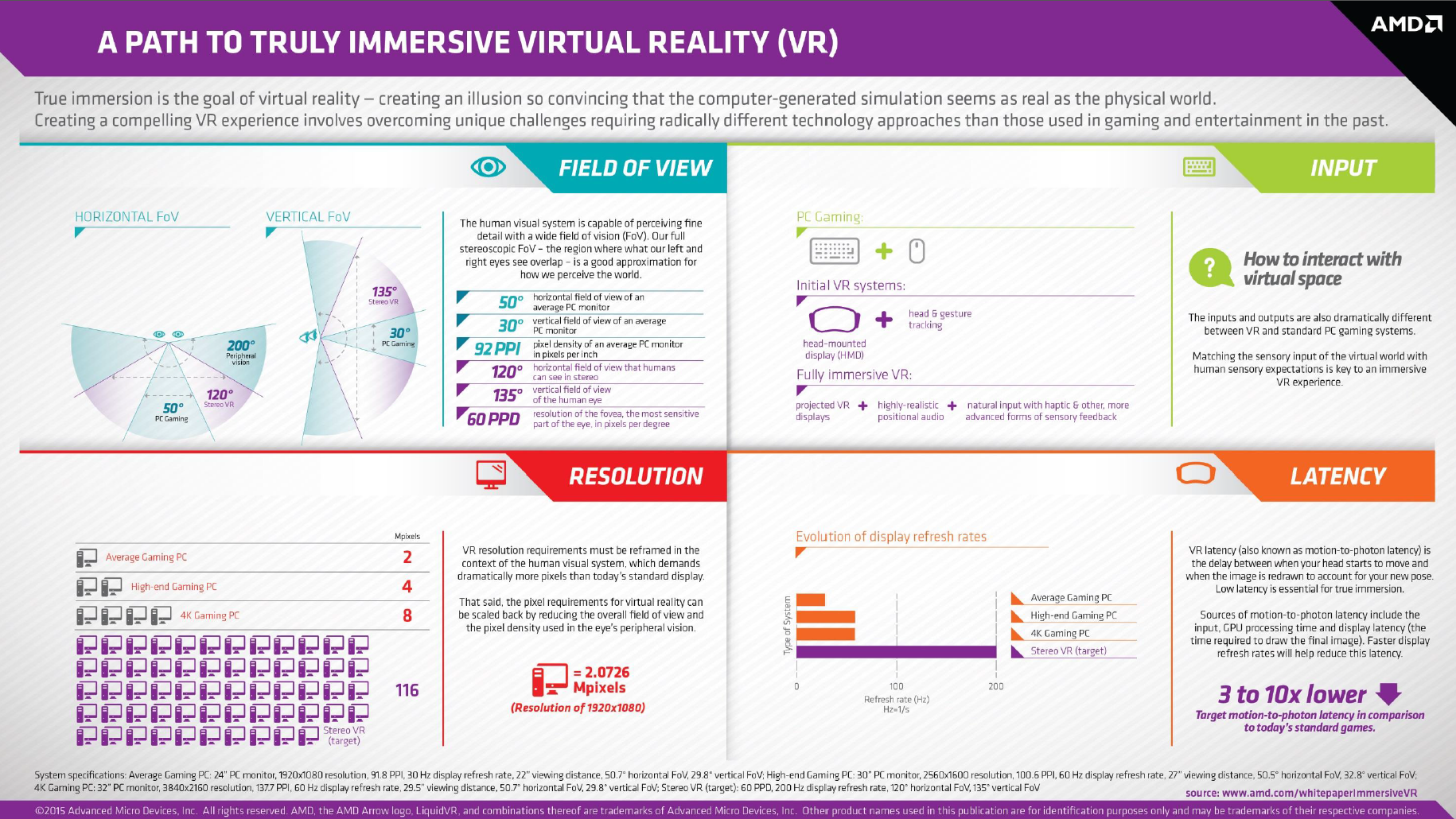AMD Determines That Absolute Immersion In VR Requires 128 Megapixel Display
AMD explains just how far away from the absolutely immersive VR experience we really are, with numbers.
While at Gamescom 2015, we sat down with a number of representatives from AMD, who gave us some of the company's thoughts on where it stands in VR and where it intends to go, and it devised a handful of numbers to explain its targets.
The core theme of VR is presence. Nobody seems to have precisely defined what presence really is, but it's essentially the connectedness to the experience, the way that you're part of the game or video; or put another way, it's how you forget that you're in a virtual environment. Some of the things that detract from presence are low framerates, high latency, low-display resolutions, incomplete input (such as missing hand-tracking) -- all the obvious things.
Of course, we know that AMD is working with various developers and manufacturers on its LiquidVR SDK, but what I talked to them about wasn't about LiquidVR. Instead, the red team had done some research and brought up a rather interesting subject: What do we need for a truly immersive VR experience? What do we need for absolute presence?
To explain, we must start with explaining why we shouldn't be measuring the resolutions of VR displays as we do the resolutions of computer monitors, but in a slightly different way. Here's why. Common sense would seem to say that a VR headset with a 1440p resolution will be sharper than one with a 1080p resolution, but that's not all there is to it. Two 1440p headsets may be very different, with one being sharper, and the other having a higher field of view.
That's where the issue lies -- simply expressing the resolution in a height and width doesn't tell you anything about the headset's field of view, and therefore not precisely how sharp the image will be. Instead, AMD brought up an older term -- PPD -- which is short for "Pixels Per Degree." You need PPD and two angles to give you the complete picture of a VR headset's display.
Using PPD, AMD calculated the resolution required as part of the recipe for truly immersive virtual reality. There are two parts of the vision to consider: there's the part of human vision that we can see in 3D, and beyond that is our peripheral vision. AMD's calculations take into account only the 3D segment. For good measure, you'd expand it further to include peripheral vision. Horizontally, humans have a 120-degree range of 3D sight, with peripheral vision expanding 30 degrees further each way, totaling 200 degrees of vision. Vertically, we are able to perceive up to 135 degrees in 3D.
With those numbers, and the resolution of the fovea (the most sensitive part of the eye), AMD calculated the required resolution. The fovea sees at about 60 PPD, which combined with 120 degrees of horizontal vision and 135 degrees of vertical vision, and multiplying that by two (because of two eyes) tallies up to a total of 116 megapixels.
Get Tom's Hardware's best news and in-depth reviews, straight to your inbox.
Yes, you read that right: 116 megapixels. The closest resolution by today's numbers is 16K, or around 128 megapixels.
Additionally, consider that VR needs to run at framerates above 90 FPS, and ideally with latencies below 20ms to avoid drawing you out of the presence.
If you consider that we're still a ways off from pulling off photo-realistic graphics on ordinary monitors at framerates and latencies that absolutely wouldn't be suitable for VR, and that these monitors have resolutions as high as about 8 megapixels for a 4K monitor, you can start to see that we're still quite a ways away from the hardware that allows us to create absolute presence.
So, do you now understand why Palmer Luckey, the founder of Oculus VR, really isn't digging that we don't have unlimited GPU power?
Follow Niels Broekhuijsen @NBroekhuijsen. Follow us @tomshardware, on Facebook and on Google+.
Niels Broekhuijsen is a Contributing Writer for Tom's Hardware US. He reviews cases, water cooling and pc builds.
-
dstarr3 I don't think "absolute immersion" is what companies like Oculus are after. They're just after something more immersive than twiddling joysticks to move around.Reply -
d_kuhn While a 16k resolution is not THAT far away... the ability to (in realtime) calculate and pump 130MP at 60+fps with photorealistic quality IS a long way away. No... the solution isn't to just continue developing vr exactly like we developed traditional displays... the solution is dynamic rendering. Once reliable and FAST eye tracking is added to a vr headset you can start rendering at high density only there the eye can actually SEE high density (where the fovea is pointed), once you get maybe 10-20 degrees off that point you can dramatically simplify the rendering to only render things that the eye sees off-axis. The GPU workload as well as the display bandwidth required would be a fraction required for a full render (too lazy to calculate but I'd guess 5-10% or so). It's quite possible that todays high end graphics cards could handle the load... so lets figure out how to calculate eye position... I want my full fov vr headset soon!Reply -
InvalidError Reply
While the human eye may not be able to discern individual pixels beyond a certain pixel density given a specific distance, the improvement in sharpness is still perceivable a fair bit beyond that.16444883 said:But the human eye can't see above 720p and 30FPS /s.
If you print text at 300dpi and 600dpi using a laser printer, the sharper cleaner text at 600dpi should be fairly easy to identify.
Is the massive increase in compute power required really worth the small improvement in image sharpness? I doubt many people are going to be willing to spend 4X as much on compute power to gain maybe 10% in perceived image quality. -
none12345 We dont need 90 fps but we certainly need very low latency. As long as input from human till frame rendered to screen is 20 ms thats fine. If they mean 20ms input lag then the frame render lag, then the frame display lag(dont even get me started on double/tripple buffering), then thats way way too slow.Reply -
CSPhobos Reply16K is a bit over 132.7 megapixels, not 128.
But 15K isn't a power of 2. We improve resolution in powers of 2. -
Christopher1 ReplyBut the human eye can't see above 720p and 30FPS /s.
Actually, that is true if you replace 720p with 1080p and 30fps with 60 fps.
-
dstarr3 Reply16444883 said:But the human eye can't see above 720p and 30FPS /s.
If your eyes can't resolve anything higher than 720p/30, you have a pretty severe handicap.



